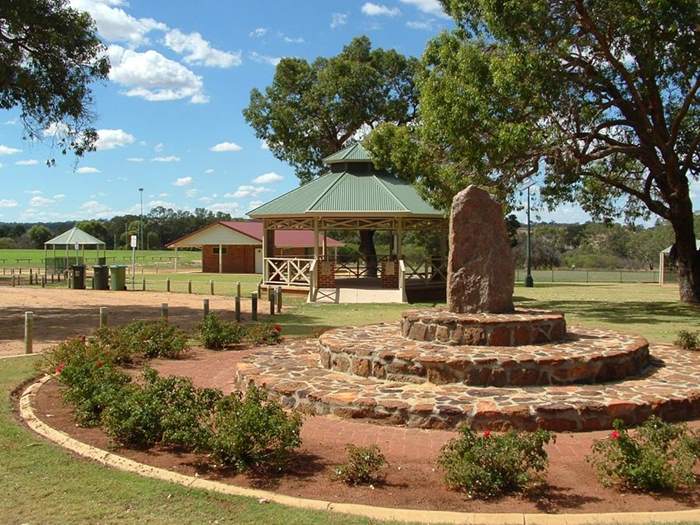|
|
|||
|
|
|
|
|
|
|
|||
|
|
DANDARAGAN
GPS 30 40 12 S 115 42 11 E
|
|||||||||
| ||||||||||
|
|
||||||||||
|
WE NEED YOUR SUPPORT. |
||||||||||
|
|
|
|
|
STATISTICS
SERVICES
CARAVAN PARKS
HOTEL / MOTEL / B and B
|
DESCRIPTION
Dandaragan's economy is based on broad acre farming, fishing and to a lesser extent tourism. The shire encompasses Dandaragan itself as well as Cataby, Regans Ford, Cervantes and Jurien on the coast.
The inland towns of the shire are still essentially backwaters with only the coastal towns of Cervantes and Jurien showing signs of major change in recent years.
Perhaps it is not all that surprising that the Shire Council has now relocated from Dandaragan to a much more pleasant location on the coast at Jurien Bay.
HISTORY
Augustus Gregory surveyed the area and named many landmarks in 1849 including Dandaraga Spring. The original Aboriginal name, Dandaraga, persisted until 1932 when the current name was adopted and in 1972 even the spring was re-named to come in line with the town. The name has also been spelled Dandarragan and Dundarragan.
The name is said to come from an Aboriginal word, 'dandaraga' which means good kangaroo country.
Despite the fact that a police station was established in the 1850s and a school opened in 1885, followed by a post office a year later and the Road Board was established in 1890, it wasn't until 1958 that the town site was gazetted.
Initially shepherds and their flocks moved into the area during winter from the Avon Valley and returned south when the hot weather came.
Their use of crown land in this way was illegal but as they were on the fringes of civilisation there was little the authorities could do about it. Eventually Governor Hutt introduced short term leases and some extra revenue was gained but many shepherds continued to squat illegally.
The authorities did not want settlement to expand too quickly because they would have to expend more money on providing services and because settlers would not be under Government control if they were too scattered. (Government always likes to have people under it's thumb.) The Shepherd's life was difficult and lonely. They only rarely got a visit from overseers who brought in mail an supplies and apart from the everyday hardships of fending off dingoes, dealing with sick sheep and finding water, they were constantly under threat from the local Aborigines who did not take kindly to their scarce water resources being taken over by these outsiders.
Finally the Government relented and an expedition was organised in 1849 to see what the area had to offer. Edward Hester who was part of the team wrote the following in his diary when they stopped overnight at Dandaraga Spring:
'Generally speaking, travelled over good land to a very excellent spring, which has a very fine grassy flat; at a little distance we could see plenty of good land upon the hills; the country generally is so bare of trees that there is no difficulty in seeing the good land extending for miles.'
The coastline was found to be very inhospitable so unlike other areas were land near the sea was the first to be taken up, in Dandaragan it was the inland plateau that settlers first selected.
The Drummond family had initially squatted in the area and then took up temporary leases as they became available. In 1850 they were the first to take up freehold land and were followed by R. Brockman and Walter Padbury.
Development in the shire was fragmented and very slow. Because of the isolation and lack of facilities people were not drawn to the area and by the early 1950s the population was still the same as it had been at the turn of the century. This resulted in a lack of income for the Road Board and meant little development was possible. This in turn kept people away and so it went, round and round, no people, no money, no people.
Neighbouring Moora experienced a 1000% population growth over the same period and therefore had a much greater revenue base.
The shire saw little change until after World War II when modern farming techniques began to arrive and people with a little more leisure time started looking at areas along the coast to spend their holidays.
TALL TALES AND TRUE
Harry Butler poisons rabbits!
Well, not the Harry Butler we know from Television, (I couldn't resist the by-line) but in 1919 another Harry Butler was appointed vermin inspector and was responsible for distributing poison to land holders to try and eradicate rabbits. (It didn't work!)
MAP
VIDEO
PROBLEM PLAYING THESE ON FIREFOX?
OTHER INFORMATION
ATTRACTIONS
Regan's Ford picnic site, Bidgerabbie Estate Vineyard, Phoebe's Reserve, Aggie's Cottage, Pioneer Park
BUILDINGS OF NOTE
St Anne's Church, Moora-Caro Road 1885, Post and Telegraph Office and Quarters 1896, Road Board Secretary's Residence, Wolba Cottage or Aggie's Cottage 1871.
ELECTORAL ZONES
State : Moore Federal : Durack
OTHER INFO.
Postcode : 6507 Local Government : Shire of Dandaragan-Tambellup
PHOTOS Click on a thumbnail to see full sized picture.
|
|
Become a supporter of this website for just $5 a month
|










